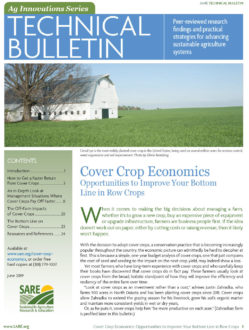
Almost any farmer with several years of cover crop experience will report that they have seen improvements in both the soil and crop performance over time. “You will have a cost savings if you stay with it,” Sneed says. To better understand how the number of years spent planting a cover crop impacts crop yield, data was collected from farmers responding to the SARE/CTIC National Cover Crop Survey.1 Farmers who planted cover crops on some fields but not on others, and who otherwise managed those fields similarly, were asked to report on respective yields (Table 1). Though not all farmers had comparable fields with and without covers to report on, there were still several hundred farmers who provided yield data each year. The biggest yield differences were reported after the drought year of 2012, with average reported yield increases of 9.6% in corn and 11.6% in soybeans. Based on the high corn and soybean prices following the 2012 drought year, cover crops provided a helpful profit boost that year.
It is important to point out that although the several hundred farms reporting data represent a good-sized data set, these were self-reported numbers. Also, it was clear that yields from field to field varied, with few fields having yield losses after cover crops and with some fields showing no difference. Many farmers reported a yield increase on their fields, but individual experiences varied. While the SARE/CTIC survey data set is by far the largest set available on cover crop yield impacts, it is worth noting that other cover crop studies have reported a range of yield impacts, from minor losses to minor increases in corn yields. For soybeans, some studies have shown that yields are unchanged with cover crops, while others have shown a modest improvement in yields. Fewer data reports are available on the yield impact of cover crops on other cash crops.
| Crop Year | Corn | Soybeans |
| 2012 | 9.6% | 11.6% |
| 2013 | 3.1% | 4.3% |
| 2014 | 2.1% | 4.2% |
| 2015 | 1.9% | 2.8% |
| 2016 | 1.3% | 3.8% |
| 1 Data is from the SARE/CTIC National Cover Crop Surveys conducted annually for crop years 2012–2016. |
For cropping years 2015 and 2016, the survey included an additional question: How many years have you consecutively used cover crops in the fields for which you are reporting yields? Using those two years of data, a simple linear regression analysis was done to look at yield response. The farmer data set for those two years is very similar in a number of metrics, indicating a high percentage of the same farmers filled out the survey both years, so it was deemed valid to take an average of the two years of data (crop years 2015 and 2016), covering yields of about 500 farmers each year. From that regression analysis, Table 2 was constructed to look at how yields change in response to duration of cover crop use in a field.
| One Year | Three Years | Five Years | |
| Corn | 0.52% | 1.76% | 3% |
| Soybeans | 2.12% | 3.54% | 4.96% |
| 1 Figures shown are an average of yields from the 2015 and 2016 growing seasons, with yield data obtained from about 500 farmers each year through the SARE/CTIC National Cover Crop Survey. |
The regression analysis of yields based on duration of cover cropping clearly showed that corn and soybean yields increased in response to the number of years that cover crops were planted in a field. This is presumably a reflection of improvements in soil health.
1 The National Cover Crop Survey was conducted for five years covering the 2012–2016 cropping seasons. The survey was done by Conservation Technology Information Center staff with funding from SARE. In years three to five of the survey, partial funding was also provided by the American Seed Trade Association. Typically, about 2,000 farmers filled out the survey in years two to five of the survey, while in the first year 759 farmers responded. The full reports on the survey are available at sare.org/covercropsurvey.
